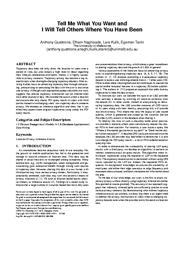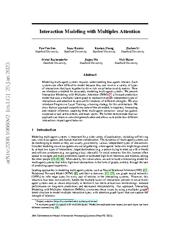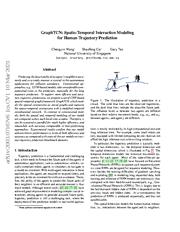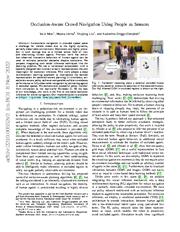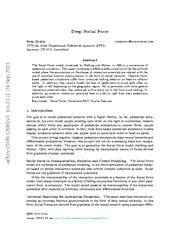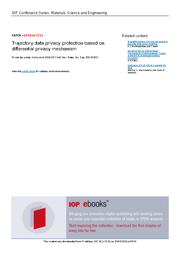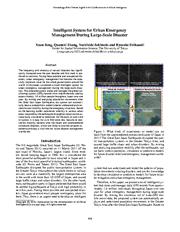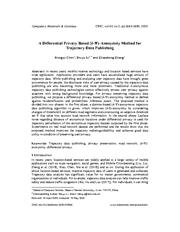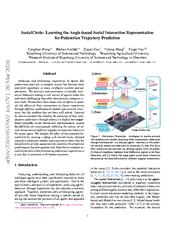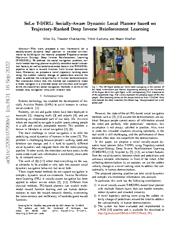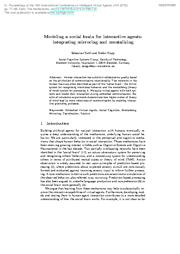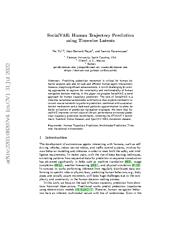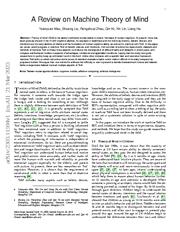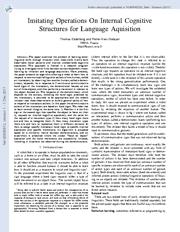A copy of this work was available on the public web and has been preserved in the Wayback Machine. The capture dates from 2016; you can also visit the original URL.
The file type is application/pdf.
Filters
Tell Me What You Want and I Will Tell Others Where You Have Been
2014
Proceedings of the 23rd ACM International Conference on Conference on Information and Knowledge Management - CIKM '14
We develop an inference algorithm and show that it can effectively approximate original trajectories using solely the POI query results. ...
Although such approaches appear plausible, our work suggests that precise trajectory information can be inferred even from other sources of data. ...
We draw circles with r radius around the location of each GPS point (Figure 1a ) and estimate the attack success based on the circles. ...
doi:10.1145/2661829.2661866
dblp:conf/cikm/QuattroneNKT14
fatcat:i5biy66q4jgglpymz44lmr4xzu
Interaction Modeling with Multiplex Attention
[article]
2023
arXiv
pre-print
We show that our approach outperforms state-of-the-art models in trajectory forecasting and relation inference, spanning three multi-agent scenarios: social navigation, cooperative task achievement, and ...
Such systems are often difficult to model because they can involve a variety of types of interactions that layer together to drive rich social behavioral dynamics. ...
Solid lines: ground truth future trajectories. Circles: predicted future trajectories. ...
arXiv:2208.10660v2
fatcat:7u6mcctaz5f5xc7vk2azljx2wq
GraphTCN: Spatio-Temporal Interaction Modeling for Human Trajectory Prediction
[article]
2021
arXiv
pre-print
To support more efficient and accurate trajectory predictions, we propose a novel CNN-based spatial-temporal graph framework GraphTCN, which models the spatial interactions as social graphs and captures ...
., LSTM-based models, take considerable computational costs in the prediction, especially for the long sequence prediction. ...
The circle color shows the attention at each time step, and the circle size corresponds to the attention weight. The green trajectory without circles denotes the target pedestrian. Social attention. ...
arXiv:2003.07167v6
fatcat:qtbziqtmijekjnmfps34rtoxzu
Occlusion-Aware Crowd Navigation Using People as Sensors
[article]
2022
arXiv
pre-print
We propose integrating such social inference techniques into the planning pipeline. ...
To the best of our knowledge, this work is the first to use social occlusion inference for crowd navigation. ...
We employ our model-free, learning-based approach to intelligently reason about a partially observable environment based on observed social context. ...
arXiv:2210.00552v2
fatcat:nifzbbjqy5bsjgvmrgnnmnozf4
Deep Social Force
[article]
2021
arXiv
pre-print
Classical force-based pedestrian simulations suffer from unnatural locking behavior on head-on collision paths. ...
The Social Force model introduced by Helbing and Molnar in 1995 is a cornerstone of pedestrian simulation. ...
suggest a social tensor to represent human-human interactions. Gupta et al. (Gupta et al., 2018) present an adversarial training to learn the distribution of trajectories. ...
arXiv:2109.12081v1
fatcat:llvw7gfi2fhcpkf6cfydwx57hq
Trajectory data privacy protection based on differential privacy mechanism
2018
IOP Conference Series: Materials Science and Engineering
In this paper, we propose a trajectory data privacy protection scheme based on differential privacy mechanism. ...
In the proposed scheme, the algorithm first selects the protected points from the user's trajectory data; secondly, the algorithm forms the polygon according to the protected points and the adjacent and ...
Current location data privacy protection methods [1, 21] are mainly classified to three categories: the heuristic privacy-measure methods, the probability-based privacy inference methods and the privacy ...
doi:10.1088/1757-899x/351/1/012017
fatcat:4hbra6qrqbfhxie66ty54wssfu
Intelligent System for Urban Emergency Management during Large-Scale Disaster
2014
PROCEEDINGS OF THE THIRTIETH AAAI CONFERENCE ON ARTIFICIAL INTELLIGENCE AND THE TWENTY-EIGHTH INNOVATIVE APPLICATIONS OF ARTIFICIAL INTELLIGENCE CONFERENCE
Based on the learning model, population mobility in various urban areas impacted by the earthquake throughout Japan can be automatically simulated or predicted. ...
Based on the constructed mobility graph, the inference model was able to be developed by using the Markov Decision Process (MDPs). ...
Model Learning and Probabilistic Reasoning Inference Model Learning Based on the constructed population mobility graph, the inference model is able to be developed by using the Markov Decision Process ...
doi:10.1609/aaai.v28i1.8758
fatcat:7b32hgbad5h5hhagxogikstzjm
Information Flow Security Models for Cloud Computing
2020
Computers Materials & Continua
For privacy preserving trajectory data publishing, we propose a differential privacy based (k-Ψ)-anonymity method to defend against re-identification and probabilistic inference attack. ...
In recent years, mobile Internet technology and location based services have wide application. Application providers and users have accumulated huge amount of trajectory data. ...
trajectory and the locations of the dummy trajectories are all within this uncertain circle. ...
doi:10.32604/cmc.2020.011232
fatcat:2ulqjw26evbjvogsj3s3t6kpku
SocialCircle: Learning the Angle-based Social Interaction Representation for Pedestrian Trajectory Prediction
[article]
2024
arXiv
pre-print
the prediction performance, but also qualitatively helps better simulate social interactions when forecasting pedestrian trajectories in a way that is consistent with human intuitions. ...
reflecting the context of social interactions at different angular orientations relative to the target agent. ...
In summary, we contribute (1) The angle-based Social-Circle representation for pedestrian trajectory prediction to model social interactive behaviors; (2) The serialized modeling strategy that treats and ...
arXiv:2310.05370v2
fatcat:mv3fwn6cvzeotbdl7qmrp4ugd4
SoLo T-DIRL: Socially-Aware Dynamic Local Planner based on Trajectory-Ranked Deep Inverse Reinforcement Learning
[article]
2022
arXiv
pre-print
This work proposes a new framework for a socially-aware dynamic local planner in crowded environments by building on the recently proposed Trajectory-ranked Maximum Entropy Deep Inverse Reinforcement Learning ...
To address the social navigation problem, our multi-modal learning planner explicitly considers social interaction factors, as well as social-awareness factors into T-MEDIRL pipeline to learn a reward ...
The main challenge in social navigation is to infer the underlying social dynamics of humans in the scene [7] . ...
arXiv:2209.07996v1
fatcat:ntlabbgmxvc57dgqv6a3p2gnwq
Modeling a Social Brain for Interactive Agents: Integrating Mirroring and Mentalizing
[chapter]
2015
Lecture Notes in Computer Science
Human interaction has a distinct collaborative quality based on the attribution of communicative intentionality. ...
Two networks in the human brain are often described as part of the "social brain": the mirror system for recognizing intentional behavior and the mentalizing (theory of mind) system for processing it. ...
The basis for complex inference is "Communicative Intention", inferred from social gaze. ...
doi:10.1007/978-3-319-21996-7_8
fatcat:t4fho4nv3ze4fisal63myy6lwe
SocialVAE: Human Trajectory Prediction using Timewise Latents
[article]
2022
arXiv
pre-print
In this paper, we propose SocialVAE, a novel approach for human trajectory prediction. ...
The core of SocialVAE is a timewise variational autoencoder architecture that exploits stochastic recurrent neural networks to perform prediction, combined with a social attention mechanism and a backward ...
By nature, they cope better with uncertainty on overall trajectories but struggle on fine-grained variations due to social interactions. Learning-based Models. ...
arXiv:2203.08207v4
fatcat:lpx2g7w3pzhhhbbzl2glhasgze
A Review on Machine Theory of Mind
[article]
2023
arXiv
pre-print
ToMnet+ tries to infer the current agent's social network from the past trajectories, and uses the inferred social network to help predict the best target for the agent in obtaining social support. ...
that ToMNet+ can infer simple social networks. ...
arXiv:2303.11594v1
fatcat:kil4q4icbracnnkbcwt73aqwdu
It Is Not the Journey but the Destination: Endpoint Conditioned Trajectory Prediction
[article]
2020
arXiv
pre-print
A novel non-local social pooling layer enables PECNet to infer diverse yet socially compliant trajectories. ...
PECNet infers distant trajectory endpoints to assist in long-range multi-modal trajectory prediction. ...
Solid circles represent the past input & stars represent the future ground truth. Predicted multi-modal trajectories are shown as translucent circles jointly for all present pedestrians. ...
arXiv:2004.02025v3
fatcat:3io6h3ogrjfuxmzbovdxowc5qy
Imitating Operations On Internal Cognitive Structures for Language Aquisition
2011
Frontiers in Computational Neuroscience
In this paper the communicative actions of the interactant are based on hand signs. ...
An algorithm is proposed based on a similarity metric between demonstrations, and an experiment is presented where the unseen "focus on object" operation and the hand movements are successfully imitated ...
If trajectory A is a circle around 0, 0 in coordinate system 1 and trajectory B is a circle around 0, 0 in coordinate system 3 they will probably look similar (trajectory A viewed in another coordinate ...
doi:10.3389/conf.fncom.2011.52.00013
fatcat:zlycgrgzbjerrlujgbaz5z7k2q
« Previous
Showing results 1 — 15 out of 31,837 results

